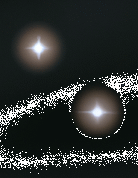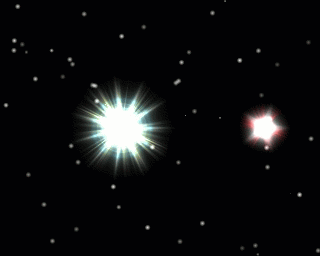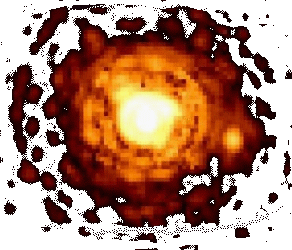   About one half of all stars which we see in the sky are in a double or multiple star system. A double star system is called a binary system.
This is not accidental. The process of star formation tends to cause many stars to be formed close to each other. In multiple star systems, including binaries, the stars all orbit about the common centre-of-mass of the system under their mutual gravitational attraction. The centre of mass is always closer to the heavier star.
About one half of all stars which we see in the sky are in a double or multiple star system. A double star system is called a binary system.
This is not accidental. The process of star formation tends to cause many stars to be formed close to each other. In multiple star systems, including binaries, the stars all orbit about the common centre-of-mass of the system under their mutual gravitational attraction. The centre of mass is always closer to the heavier star.
 Close pairings of stars in the sky have been recognised since antiquity, but were thought to be just chance superpositions along the line of sight of two unrelated stars. In 1767 John Michell realised that there are too many doubles to be explained by chance, and that often the two stars must actually be physically associated. In 1803, William Herschel discovered the first binary star Castor, in the constellation Gemini. By 1821, he had completed the first major catalogue of 848 binary stars. Today, over 100,000 are known. Close pairings of stars in the sky have been recognised since antiquity, but were thought to be just chance superpositions along the line of sight of two unrelated stars. In 1767 John Michell realised that there are too many doubles to be explained by chance, and that often the two stars must actually be physically associated. In 1803, William Herschel discovered the first binary star Castor, in the constellation Gemini. By 1821, he had completed the first major catalogue of 848 binary stars. Today, over 100,000 are known.In 1991-2, teams led by Michel Mayor and Geoffrey Marcy surveyed the stars in our solar neighbourhood and found that nearly half were binary, and most had highly eccentric orbits. Stars form from the collapse of the giant gas clouds of molecular hydrogen which populate the spiral arms of our galaxy. Computer simulations of the gravitational collapse of a molecular cloud indicate that if the cloud rotates faster than a critical rate of approximately one revolution every two million years, the cloud will fragment into binary protostars with highly eccentric orbits. This prediction has been confirmed by observations, which show that about half of the observed dense cloud cores rotate faster than the critical rate and so will likely go on to form binary protostars. There are several kinds of binary star systems, based on how we identify them: -- A visual binary is one in which the two stars can be observed in a telescope to orbit their common centre of mass. Below is an image taken by the Hubble Space Telescope of Gliese 623, where the two stars are separated by 2 A.U. [One astronomic unit is the distance from Earth to our Sun]  -- An astrometric binary is one where we can observe one star of the pair wobbling as the pair revolve around each other; the other star being too faint to see. Sirius, the brightest star in the sky, was classified as an astrometric binary until its faint companion was discovered in 1862 by Alvan Clark. Its companion is now known to be a white dwarf star. Really good orbital data are available for only about 50 visual binaries, although another 2000 are known to some degree of accuracy. Combined with a knowledge of their distances, visual binary orbits provide one of the best means of determining stellar masses. -- The Doppler Effect can also be used to identify binaries as the stars alternately approach and recede from the Earth in their orbital motion around the binary centre of mass. -- An eclipsing binary is one which shows regular light variations due to one of the stars passing directly in front of its companion, as viewed from the Earth.   Eclipses, two per orbital period, are only likely to occur if the separation between the two stars is small and if the inclination of the orbital plane to the line of sight is close to 90 degrees. The same surface area is hidden at each eclipse, so the primary, or deeper, eclipse occurs when the hotter (i.e. highest surface brightness) star is eclipsed. It is believed that during the formation of our own solar system more than 5 billion years ago, the Sun would have had a binary companion star in Jupiter, but that planet wasn't quite massive enough for its gravitational collapse to turn on nuclear fusion.  |